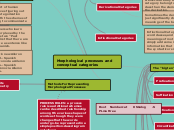Prefixes and Suffixes
A noun is a word that functions as the name of some specific thing or set of things, such as living creatures, objects, places, actions, qualities, states of existence, or ideas.
Generic nouns are nouns that are part of a generic statement. Generic nouns can be singular or plural. The opposite of generic nouns is collective nouns.
The difference between definite/indefinite and generic nouns is that in the sentence there must be a blanket statement or question.
Prefixes
Proper nouns are the names of specific people or places. They should always begin with a capital letter.
A prefix is a group of letters placed before the root of a word. For example, the word “unhappy” consists of the prefix “un-” [which means “not”] combined with the root (or stem) word “happy”; the word “unhappy” means “not happy.”
CONNECTORS TO EXPRESS REASONS
A concrete noun is a noun that can be identified through one of the five senses (taste, touch, sight, hearing, smell).
Because: Sentence
Because of: noun-noun phrase
Due to: noun-noun phrase
For: sentences-noun –noun phrase
In order to: verb.
To: verb
Possessive nouns are nouns which possess something, normally another noun.
Add examples
Common nouns are words for people, places or things that aren’t specific (as opposed to a proper noun which refers to only one person, place or thing).
Common nouns can be countable or uncountable, singular or plural.
SUFFIXES
A noun which refers to a group of things/people.
A suffix is a group of letters placed after the root of a word. For example, the word flavorless consists of the root word “flavor” combined with the suffix “-less” [which means “without”]; the word “flavorless” means “having no flavor.”
PREFIX AND SUFFIX
A noun which cannot be identified by using one of the five senses (taste, touch, sight, hearing, smell).
Example
NEGATIVE PREFIXES
Irregular nouns are nouns which don’t follow a spelling pattern when pluralized.
Negative statements are the opposite of affirmative statements. In English, one way to make negative statements is by adding negative prefixes to nouns, adjectives, and verbs. Here are some English negative prefixes: a–, dis–, il–, im–, in-, ir–, non–, un–









